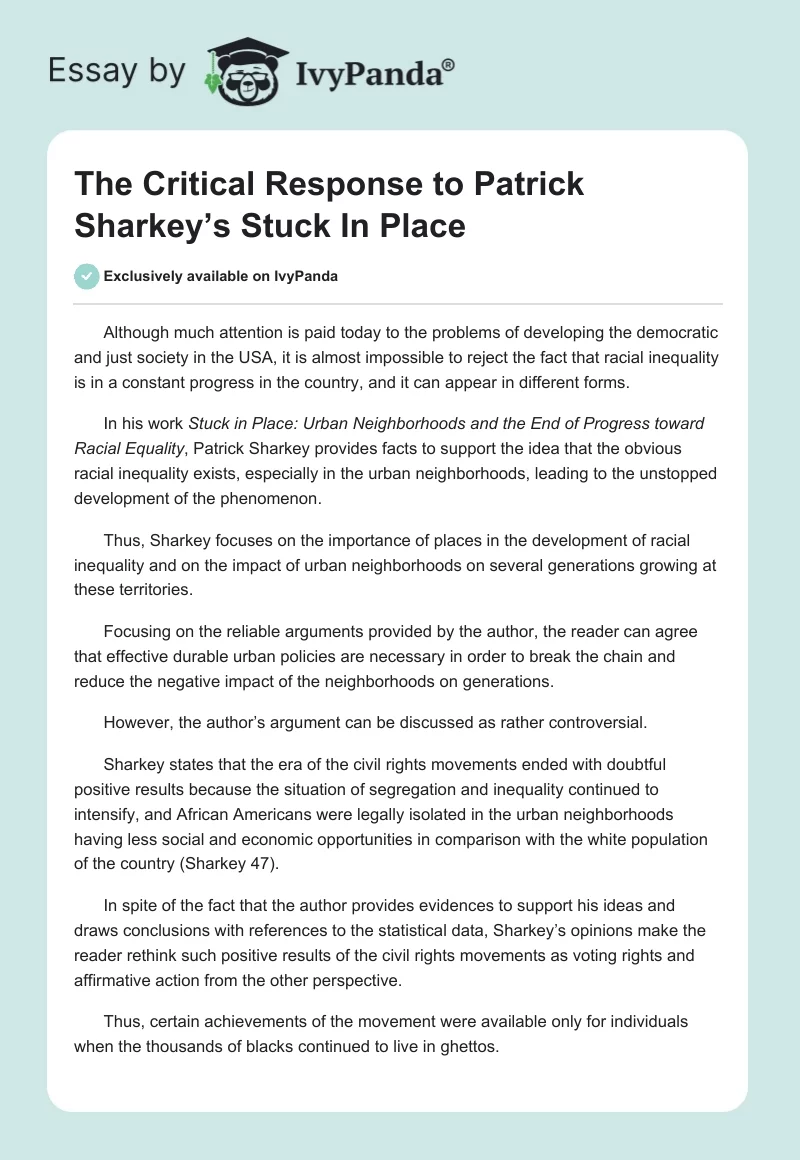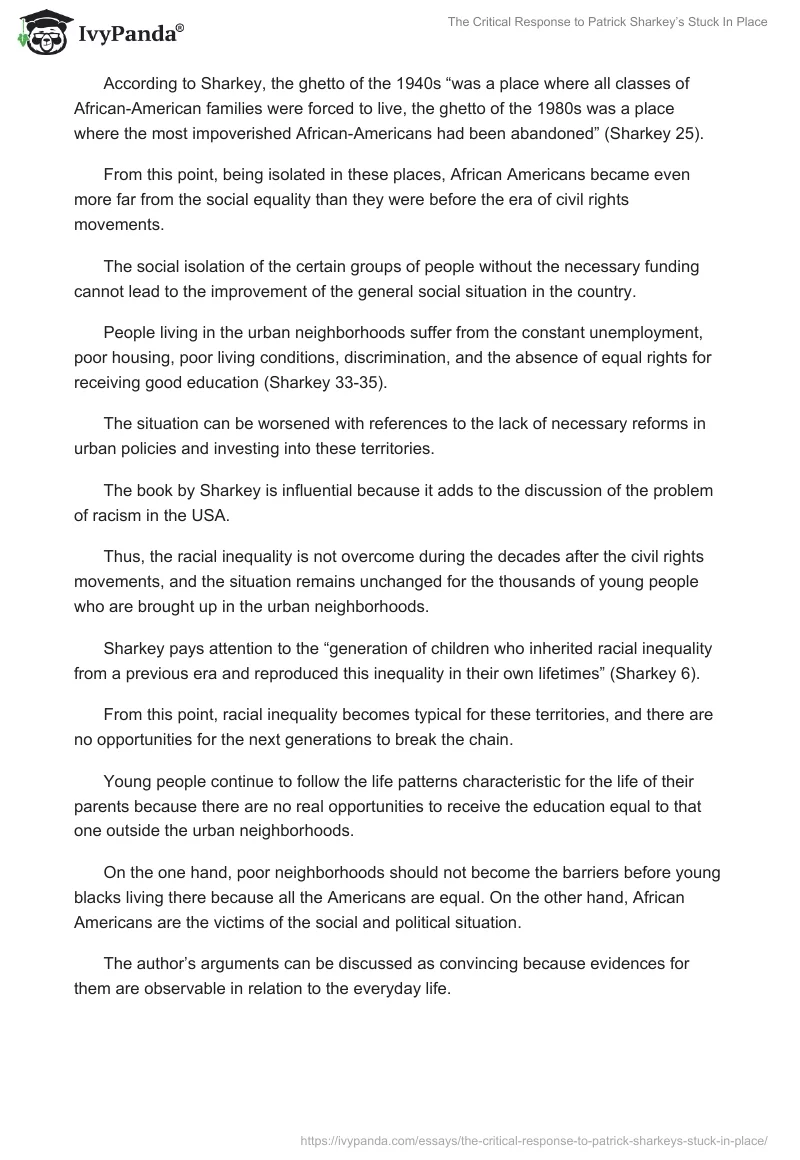Although much attention is paid today to the problems of developing the democratic and just society in the USA, it is almost impossible to reject the fact that racial inequality is in a constant progress in the country, and it can appear in different forms.
In his work Stuck in Place: Urban Neighborhoods and the End of Progress toward Racial Equality, Patrick Sharkey provides facts to support the idea that the obvious racial inequality exists, especially in the urban neighborhoods, leading to the unstopped development of the phenomenon.
Thus, Sharkey focuses on the importance of places in the development of racial inequality and on the impact of urban neighborhoods on several generations growing at these territories.
Focusing on the reliable arguments provided by the author, the reader can agree that effective durable urban policies are necessary in order to break the chain and reduce the negative impact of the neighborhoods on generations.
However, the author’s argument can be discussed as rather controversial.
Sharkey states that the era of the civil rights movements ended with doubtful positive results because the situation of segregation and inequality continued to intensify, and African Americans were legally isolated in the urban neighborhoods having less social and economic opportunities in comparison with the white population of the country (Sharkey 47).
In spite of the fact that the author provides evidences to support his ideas and draws conclusions with references to the statistical data, Sharkey’s opinions make the reader rethink such positive results of the civil rights movements as voting rights and affirmative action from the other perspective.
Thus, certain achievements of the movement were available only for individuals when the thousands of blacks continued to live in ghettos.
According to Sharkey, the ghetto of the 1940s “was a place where all classes of African-American families were forced to live, the ghetto of the 1980s was a place where the most impoverished African-Americans had been abandoned” (Sharkey 25).
From this point, being isolated in these places, African Americans became even more far from the social equality than they were before the era of civil rights movements.
The social isolation of the certain groups of people without the necessary funding cannot lead to the improvement of the general social situation in the country.
People living in the urban neighborhoods suffer from the constant unemployment, poor housing, poor living conditions, discrimination, and the absence of equal rights for receiving good education (Sharkey 33-35).
The situation can be worsened with references to the lack of necessary reforms in urban policies and investing into these territories.
The book by Sharkey is influential because it adds to the discussion of the problem of racism in the USA.
Thus, the racial inequality is not overcome during the decades after the civil rights movements, and the situation remains unchanged for the thousands of young people who are brought up in the urban neighborhoods.
Sharkey pays attention to the “generation of children who inherited racial inequality from a previous era and reproduced this inequality in their own lifetimes” (Sharkey 6).
From this point, racial inequality becomes typical for these territories, and there are no opportunities for the next generations to break the chain.
Young people continue to follow the life patterns characteristic for the life of their parents because there are no real opportunities to receive the education equal to that one outside the urban neighborhoods.
On the one hand, poor neighborhoods should not become the barriers before young blacks living there because all the Americans are equal. On the other hand, African Americans are the victims of the social and political situation.
The author’s arguments can be discussed as convincing because evidences for them are observable in relation to the everyday life.
The life of young African Americans is affected in relation to all the spheres, they have lower test scores, cannot receive the appropriate higher education, and cannot be employed successfully.
It is important to understand the fact that African Americans are discriminated significantly while being isolated in ghettos.
Sharkey states that social problems that “characterize poor, segregated urban neighborhoods have not arisen because of any character deficiencies of low-income African Americans or other ethnic minorities” (Sharkey 23).
Thus, segregation was the result of discriminating policies. Many social problems emerged because of “a combination of economic and political disinvestment in urban neighborhoods” (Sharkey 23).
The strength of the book is in referring to the changes in the urban policies and provision of social mobility for African Americans living in ghettos as to the ways of coping with the racial discrimination.
These policies can change the whole situation and help in stating equality according to the principles of a just society.
The situation can be changed with the help of providing people living in ghettos with more social mobility, more chances, and more equality. Sharkey proposes focusing on a specific durable urban policy which should be realized gradually in order to result in positive changes (Sharkey 23, 168).
The author defines the durable urban policy as the policy with the capacity “to create changes that persist across generations of families, and policies that are less vulnerable to the changing political mood in Washington or to the fluctuations of the business cycle” (Sharkey 23).
Thus, social equality is possible when the vision of this idea does not depend on the political changes. The reader can agree with the statement that “any form of discrimination in the housing and lending market must be challenged aggressively” (Sharkey 178).
Nevertheless, despite the planned actions proposed by the author, the realization of the policy can become a challenging process because policy makers were inclined to be blind to the hidden discrimination and inequality during decades.
The arguments and data provided by Sharkey in his book allow speaking about the development of the catastrophic tendency which leads to intensifying the racial discrimination instead of supporting the idea of equality.
In his book, Sharkey presents the logical discussion of the problem of the urban neighborhoods in relation to their impact on the generations of the African Americans living in societies which “remained ‘hypersegregated’” (Sharkey 25).
Thus, the author’s ideas are significant to examine the problem of discrimination with references to the role of poor neighborhoods and social isolation. Focusing on this aspect, it is possible to make first steps in overcoming the problem.
The American people are used to focus on the idea that the American society provides equal opportunities for all the population in spite of differences. In reality, equality remains to be rather mythic.
Sharkey’s book is interesting and influential because the author discusses the problem of inequality with references to the urban neighborhoods where thousands of African Americans have to live because of the ineffective urban policies.
The connection between the environments and the aspects of the African Americans’ life in ghettos was discussed as the controversial point during a long period of time.
In his book, Sharkey focuses on this connection and states that the negative environments can provoke the negative aspects of the people’s social life.
From this point, the effective urban policy can contribute to changing the situation for better. It is possible to agree with Sharkey’s position because the author’s arguments are logical, they are supported with the relevant and credible data.
Works Cited
Sharkey, Patrick. Stuck in Place: Urban Neighborhoods and the End of Progress toward Racial Equality. USA: University of Chicago Press, 2013. Print.


